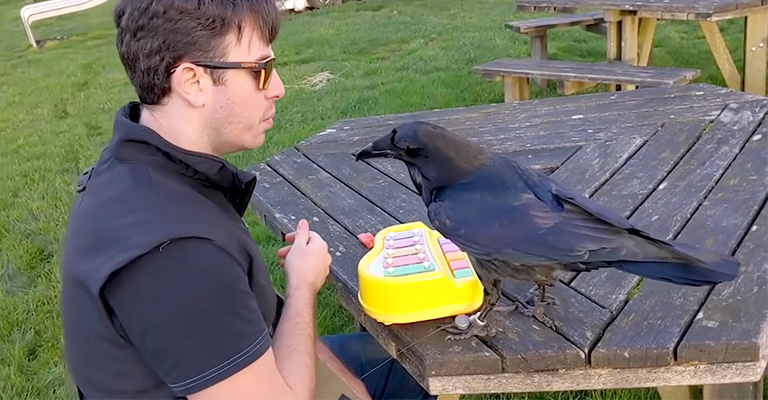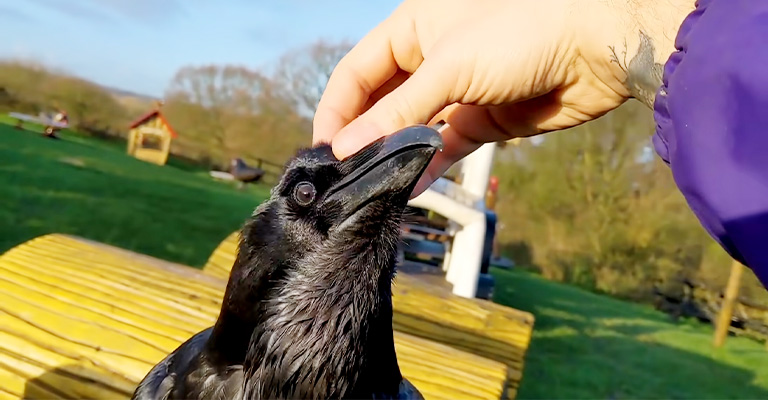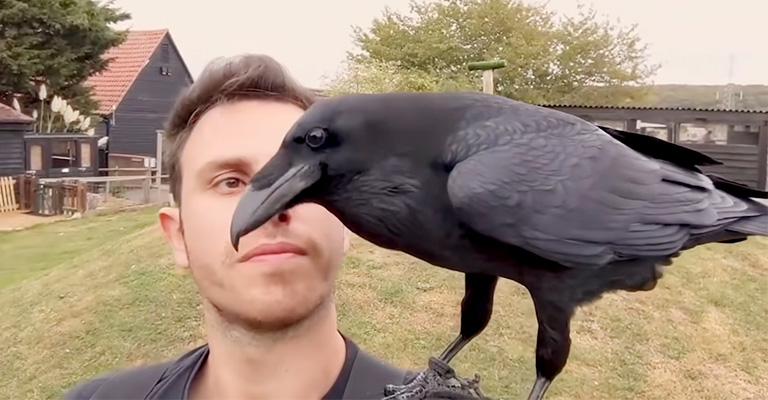Crows, with their remarkable intelligence and enigmatic allure, have fascinated humans for centuries. These avian wonders possess problem-solving abilities, recognize faces, and even use tools.
If you’ve ever wondered how to establish a connection with these captivating birds, you’ve come to the right place. In this guide, we’ll delve into the fascinating world of crow training, offering you insights on how to train a crow, and tips to develop a harmonious relationship with them.
Whether you’re a bird enthusiast, a nature lover, or simply intrigued by the mysteries of the avian realm, our step-by-step instructions will help you unlock the secrets of training crows.
From building trust to teaching them tricks, we’ll explore the nuances of communication and cooperation that make crow training a rewarding endeavor.
So, prepare to embark on a journey that brings you closer to these intelligent creatures and deepens your appreciation of the natural world.

How To Train A Crow?
Training a crow can be a fascinating and rewarding experience. These highly intelligent birds can learn a variety of tasks and tricks. Here, I’ll provide a step-by-step approach to training a crow.
Choose the Right Crow
Before you begin training, it’s important to find a crow that’s willing to engage with you. You can start by observing local crows in your area and choose one that seems more approachable. Younger crows tend to be more curious and open to interaction.
Establish Trust and Offer Food as a Reward
Crows are cautious creatures, and it’s essential to build trust with your chosen crow. Start by leaving food out in an open area where the crow can observe you from a safe distance.
Gradually move closer each day, allowing the crow to become accustomed to your presence. Food is a powerful motivator for crows. Offer a variety of food, such as nuts, fruits, and small pieces of meat. You can also use a distinct container for food to signal that it’s training time.
Train in Short Sessions and Use Positive Reinforcement
Crows have short attention spans, so keep training sessions brief, ideally under 10 minutes. Regular, consistent training is more effective than infrequent, long sessions.
Reward the crow with treats and praise when it successfully performs a desired action. Positive reinforcement, such as treats and encouraging words, helps the crow associate the action with a positive outcome.
Teach Basic Commands and Then the Complex Ones
Start with simple commands like “come” or “perch.” Use consistent hand signals or vocal cues to communicate these commands. Be patient, as it may take time for the crow to understand and respond.
Once the crow is comfortable with basic commands, you can move on to more complex tricks like fetching small objects or identifying colors. Use a step-by-step approach, breaking down the task into smaller, achievable milestones.
Socialize with the Crow and Create a Safe Environment
Spend time with the crow outside of training sessions. Sit quietly nearby and talk to the crow in a soothing tone. The goal is to form a bond and make the crow feel comfortable in your presence.
Ensure that the training area is safe for the crow. Remove any potential hazards, and consider using a designated space, such as a backyard or garden, for training.
Be Consistent and Avoid Punishment

Consistency is key to crow training. Stick to a regular training schedule, and use the same cues and rewards each time. This will help the crow learn and respond more effectively.
Crows respond poorly to punishment or negative reinforcement. If the crow makes a mistake, simply withhold the reward and try again later. Never yell at or harm the crow, as it will damage the trust you’ve built.
Keep It Fun and Provide Mental Stimulation
Training should be an enjoyable experience for both you and the crow. Keep the sessions lighthearted, and always end on a positive note, even if progress is slow.
Crows are highly intelligent birds, and they require mental stimulation. Offer puzzles or games that challenge their problem-solving abilities. This can be an enjoyable way to bond and train simultaneously.
Record Progress and Respect Boundaries
Keep a training journal to track the crow’s progress. Note what commands or tricks it has mastered and where there’s room for improvement. Adjust your training approach accordingly.
Remember that crows are wild animals, and it’s essential to respect their boundaries. If the crow shows signs of stress or discomfort, back off and give it space.
Maintain a Routine and Introduce Challenges
Crows thrive on routine, so try to establish a consistent daily schedule for training and feeding. This helps the crow anticipate training sessions and builds trust.
As the crow becomes more skilled, introduces new challenges to keep it engaged and motivated. This could include more complex tricks, longer distances, or greater obstacles.
Share Rewards and Be Patient
If you have more than one crow that you’re training, make sure to reward each one fairly and avoid favoritism. This will prevent conflicts and jealousy among them.
Crow training takes time, and progress may be slow. Patience is key to building a strong bond and achieving the desired results.
Embrace Crow’s Individuality
Each crow has its unique personality and abilities. Embrace and work with the strengths and limitations of the crow you are training.
Training a crow is a rewarding endeavor that requires patience, consistency, and a deep respect for the bird’s intelligence and individuality.
With the right approach, you can form a remarkable bond and teach a crow a variety of commands and tricks, making for a truly unique and enriching experience.
What Are the Safety Considerations While Training a Crow?

When training a crow, it’s essential to prioritize safety, both for yourself and the bird. Crows are wild animals, and even in a training context, they can exhibit unpredictable behaviors. Here are important safety considerations to keep in mind:
Protection from Zoonotic Diseases
Crows can carry diseases that can be transmitted to humans, such as West Nile virus. When handling crows, it’s essential to wear gloves and wash your hands thoroughly afterward to reduce the risk of disease transmission.
Avoid Crow Attacks
Crows can be protective of their territory and may become aggressive if they feel threatened. Avoid wearing shiny or reflective objects (like jewelry) that could be mistaken for potential threats.
If a crow becomes aggressive, back away slowly and avoid making direct eye contact, which can be perceived as a threat.
Safe Training Environment
Ensure that the training area is free from hazards. Remove any sharp objects, toxic plants, or other potential dangers that could harm the crow. Create a secure and controlled space where the crow can practice without unnecessary risks.
Protection from Predators
Crows have natural predators, and when training in an outdoor environment, it’s essential to be aware of potential threats, such as cats or larger birds. Supervise training sessions to protect the crow from harm.
Food Safety
The food you offer as reward should be safe for the crow to consume. Avoid foods that are toxic to birds, like chocolate, and be cautious about any potential contaminants in the food you provide.
Overfeeding crows can lead to health issues. Offer treats in moderation during training sessions, and avoid making the crow overly dependent on you for food.
Weather Considerations
Extreme weather conditions can be harmful to crows. Avoid training in extremely hot or cold weather, and provide shelter if necessary. Ensure that the crow has access to water during hot days.
Crows are delicate creatures, and it’s crucial to handle them gently and with care. Avoid grabbing or restraining the bird forcefully, as this can cause injury or distress.
Protecting Other Wildlife and Noise Considerations
Training a crow can sometimes attract other wildlife, like raccoons or seagulls, looking to steal the crow’s food. Take precautions to prevent unwanted interactions that might harm the crow or disrupt training sessions.
Crows can be noisy birds, and excessive noise during training may disturb neighbors or attract unwanted attention. Be mindful of your surroundings and the impact of training on the local environment.
Wildlife Regulations and Avoid Overtraining
Check with local authorities or wildlife agencies to ensure that you are in compliance with any relevant regulations or permits for training crows. Some areas may have specific rules regarding the interaction with wild animals.
Training a crow can be mentally and physically exhausting for the bird. Avoid overtraining by keeping sessions short and allowing the crow time to rest between training sessions.
Respect Boundaries
Crows have their personal boundaries, and it’s essential to respect them. If a crow shows signs of stress or discomfort, such as loud distress calls, aggression, or avoidance, give it space and reassess your training approach.
If you find a crow’s nestling or fledgling, it’s important to be aware of the laws and regulations regarding wildlife rehabilitation in your area. Handling young crows may require specific permits or professional assistance.
FAQs
Can I train any type of crow?
While it is possible to train various crow species, the American crow (Corvus brachyrhynchos) is one of the most common species in North America and is often chosen for training due to its adaptability and prevalence.
What’s the best age to start training a crow?
Younger crows tend to be more open to training and socialization. It’s often recommended to start training when a crow is a fledgling or juvenile. This allows you to build a stronger bond and introduce commands and tricks more effectively.
Can I train multiple crows at once?
Yes, you can train multiple crows simultaneously, but it can be more challenging. It’s essential to ensure each crow gets equal attention and rewards to prevent conflicts and jealousy among them.
Are there any vocal commands that work with crows?
Crows can learn vocal cues, but it’s essential to use consistent and distinct sounds. For example, you might use a unique whistle or a specific word to signal a command. Repetition and positive reinforcement are key to associating vocal cues with actions.
Can I release a trained crow back into the wild?
It’s generally recommended not to release a trained crow back into the wild. Trained crows may struggle to adapt to the challenges of the wild, and releasing them could be detrimental to their survival.
Conclusion
Training a crow is not just about teaching a bird some tricks; it’s about forming a unique bond with a highly intelligent creature. Throughout this guide, we’ve emphasized the importance of patience, consistency, and respect for these remarkable birds.
As you embark on your journey to train a crow, remember that it’s a two-way street. The experiences and memories you create in the process will be as precious as the knowledge you gain.
Whether it’s sharing a meal with your newfound crow friend or watching them thrive in their environment, this journey is sure to leave an indelible mark on your heart.
So, go forth, armed with the knowledge and compassion you’ve gained, and discover the magic of crow training for yourself. The world of these intelligent birds awaits, ready to offer you lessons in friendship and the beauty of our natural world.